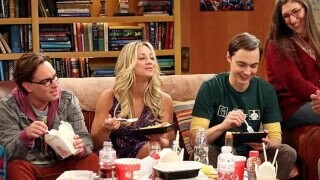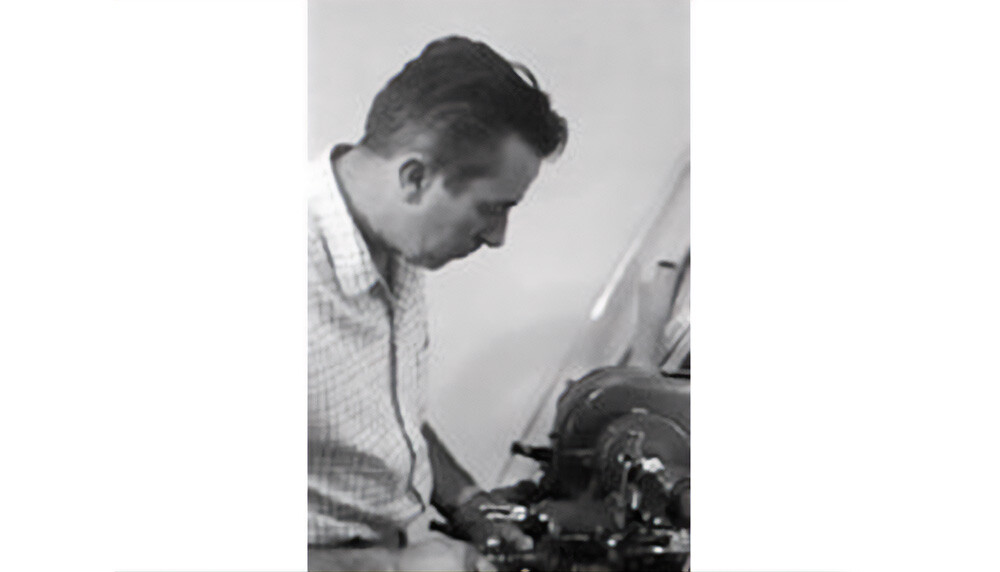The Awful, Unfunny History Of The Laugh Track

Welcome to ComedyNerd, Cracked's new deep dive series on *pause for canned hoots and hollers* comedic things. Today's topic: the laugh track. (Also, the ComedyNerd newsletter just launched. Sign up here.)
"The laugh track is the single greatest affront to public intelligence I know of." - David Niven
Okay, so canned laughs have never been popular with the cool kids. From the earliest days of televised comedy, the laugh track has been elbowing an annoyed audience in the ribs, an unsubtle nudge that says, “Hey, that was a good one!”
Don't Miss
And for that, we have one man to thank: Charles Douglass.

via Wiki Commons
By most accounts, Charles was a largely humorless guy. But he knew his way around audio equipment. His father was an engineer, and Charles followed in his geeky footsteps, working on shipboard radar gear during his Navy stint in World War II. From there, he landed a gig with CBS Radio and, eventually, a job in television.
The medium was in the process of inventing itself. And as a sound engineer, Charles discovered he could goose a comedy show by inserting a pre-recorded chuckle where a joke fell flat or mute guffaws when they went on too long. What a godsend for insecure comics like Milton Berle.
“That machine was his answer to every prayer he ever had,” said comedy writer Mel Diamond. “He didn’t need the f**king audience anymore—which he didn’t like anyway because he couldn’t depend on them. To me, the machine is as fraudulent as the phony quiz shows, but the comedians saw it as the answer to their worst fears.”
The King of the Titter Track
But sweetening the laughs was just the beginning. As the three-camera, live-audience style of I Love Lucy grew out of fashion, a new filming (and eventually videotaping) technique took hold. Now we followed the castaways around Gilligan’s Island, explored The Munsters’ haunted mansion, and accompanied Otis, the teetering town drunk, down the sleepy streets of Mayberry.

CBS
None of the locations were suitable for a live audience. But unlike the 21st century's Modern Family or Ted Lasso, that didn’t mean networks were prepared to lose the laughs.
In fact, sitcom producers were nearly as insecure as Milton Berle when it came to punchlines that weren’t met with gales of giggles. “Television executives insisted that a comedy show had to have a laugh track so the audience watching at home would know when to laugh,” complained George Burns. “I told them we didn’t need one on our show because the audience knew when something funny had happened. They still insisted we use the laugh track.”

"What are you laughing at?! I just called the executives idiots. I'm not joking!"
more laugh track
Critics did what critics do—whined and moaned. “Someone apparently didn’t have much confidence in the ability of the material and cast antics to get the required reaction from viewers,” cried one reviewer about The Phil Silvers Show. “So the show played off to the irritating accompaniment of an unnecessary titter track.”
Charles Douglass was the King of the Titter Track. By the 1960s, he had moved well beyond augmenting existing audio. Now he employed his patented Laff Box, a mysterious machine (Charles legendarily would not share its secret inner workings) that held 32 reels containing 10 laughs each.
That’s 320 laughs in all—guffaws and giggles, shrieks and snickers, ha-has and har-de hars. Douglass was like an orchestra conductor in post-production, playing just the right snickers in syncopation with the jokes, cueing the at-home audience when to laugh along. He used the Laff Box like a musical instrument; rather than pushing a play button, Douglass worked a series of foot pedals that could modulate the length, speed, and volume of the laughs. Eventually, those pedals were replaced with what looked like typewriter keys.
This feels like something Joker would build, both because of the laughter and the evil.
How did he mine the actual laughter sounds? Taking the audio from existing Honeymooners or I Love Lucy episodes was virtually impossible since the actors would speak over the gleeful audience response. So Douglass extracted laughs “from Marcel Marceau and from Red Skelton from the silent sequences,” says Ron Simon, curator of television and radio at the Paley Center for Media. The isolated sounds allowed Charles to create perfect tape loops of laughter.
That’s the reason you can actually recognize the laughs in many sitcoms of the 1960s and 1970s—they all came out of the Laff Box. Douglass had a virtual monopoly in the canned-laugh business. He’d go from show to show with his equipment, planting his yuk-yuk seeds like a comedy Johnny Appleseed (if Appleseed had the only seeds in town). Despite the lack of competition, Douglass didn’t get rich, only charging $100 a day for his services.
He almost convinced movie producers to get in on the act as well. Lee Marvin’s Cat Ballou tried out a Laff Box track at a handful of drive-in movie theaters to gauge audience response. Spoiler: everyone hated it.
“It Cheapened the Show”
Pushback against the Laff Box was inevitable. While there was something comforting about the familiar laughs that showed up on nearly every sitcom, that same familiarity underscored their inauthenticity. If your intelligence was insulted by Douglass’s gadget telling you when and how to respond to a joke, you weren’t alone.
“I always thought it cheapened the show," said M*A*S*H producer, director, and writer Larry Gelbart. Initially, CBS got its way – As Gelbart says, “They were paying for dinner.” -- and the war comedy was full of incongruous laughs. But M*A*S*H producers kept pushing to limit the use of a laugh track. “Under no circumstances would we ever have canned laughter during an OR scene," Gelbart said. "When the doctors were working, it was hard to imagine 300 people were in there laughing at somebody’s guts being sewn up.”

CBS
Watch any M*A*S*H episode from season one compared with an installment from, say, season seven, and the difference is tangible. All-out yuks are replaced with a more subdued response when fake laughs are in there. For specific episodes, like the series finale "Goodbye, Farewell and Amen," producers convinced CBS to remove the laugh track altogether. Similarly, when the series came out on DVD, grateful viewers were given the option to lose the canned laughs.
Other shows continued the push against the Laff Box, though not necessarily against laughter itself. "When Cheers starts, it says 'Cheers was recorded before a live studio audience',” says Jeremy Butler, professor of television studies at the University of Alabama. “That's their way of saying, 'No, this is not a Charles Douglass laugh track—fake laughing. This is an actual audience responding'."
(Sort of, according to TV historian Ben Glenn II. While Cheers was indeed filmed with a live audience, the laughs were still punched up in post-production by Northridge Electronics.)

NBC
The move away from canned laughs continued, though killing them all together wasn’t always practical. “We had real laughs on the scenes that were shot in front of an audience, but then we would shoot other scenes that were not in front of the audience (which didn't have any laughs), and then it felt like a bit of a mismatch,” said Jerry Seinfeld during a Reddit AMA. “So we tried to compromise and put in a subtle laugh track. I think that one of the fun things of a sitcom is feeling like you're in an audience even though you're home, watching it by yourself.”
Do canned laughs make a difference?
Laugh track vs. no laugh track—in the end, does it really affect how you watch a show?
Amateur social scientists have given us the tools for an interesting experiment: Try watching Friends without a laugh track …
… then check out a scene from The Office with a laugh track added in.
The experience is disconcerting. Like them or hate them, laugh tracks matter.
They’re even capable of prompting laughter at unfunny jokes, according to a 1974 study from The Journal of Personality and Social Psychology. The irony: Those added laughs can come at the expense of actual gags. “The secret to the brisk pace of The Simpsons,” says Ken Jennings in his book Planet Funny, was “the one thing the show didn’t have: a studio audience. It’s hard to overstate how much sitcom time and propulsion have been lost over the decades to the laugh track.”

NBC
Shows like The Simpsons accelerated the trend toward laughless sitcoms. The Office, Parks and Rec, Malcolm in the Middle, and Modern Family picked up the baton, trusting the audience in the way George Burns suggested half a century ago.
Check out this year’s Emmy nominees for Outstanding Comedy Series: Ted Lasso, PEN15, The Flight Attendant, Black-ish, Cobra Kai, Hacks, Emily In Paris, and The Kominsky Method. Not a single canned laugh (or any laughs in Emily In Paris) in the bunch. But the laugh track is not dead yet. At least not if CBS has anything to say about it. From recent hits How I Met Your Mother to Two and a Half Men to Big Bang Theory, the network still believes there’s an audience for sitcoms that drop in audience laughs.

ABC
Doesn’t that make those sitcoms seem old-fashioned? "Whenever anybody would make that argument,” says producer Chuck Lorre, “the first thing I would say is that Big Bang Theory has been sitting at top or near the top of the ratings." But fake laughs aren’t allowed, Lorre insists. “I do not, and have never, sweetened my shows with fake laughs. I’ve always thought it was a pretty hateful and self-defeating practice.”
If anything, today’s laugh tracks, when they exist at all, are going in the other direction from the Laff Box days. Think of it as almost anti-sweetening. Check out an episode of How I Met Your Mother, a show shot in an empty studio, suggests Josef Adalian. Audio engineers added laughs, but they were “digitally massaged … mellow, hoots and catcalls virtually absent.”
It’s the same old song but stripped down for a more authentic sound. Imagine an overwrought musical score distracting from the drama playing out on screen vs. a musical backdrop that enhances a story’s natural tension and release. Not unlike Douglass’s playing the Laff Box like a church organ, today’s engineers are attempting to compose a more subtle score.
Maybe even David Niven would approve.
Top Image: Warner Bros. Television
For more ComedyNerd, be sure to check out:
4 Things Created A Perfect Storm For '80s Teen Sex Comedies
That Time My Friend Wrestled Andy Kaufman
Everybody Was Too Annoyed With Lena Dunham To Appreciate 'Girls'
How Eddie Murphy Saved SNL From Extinction
In Defense Of 'Scott's Tots': Why 'The Office's Most Excruciating Episode Is Also Its Most Necessary
How Joe Rogan Went From Fairly Unknown Comic To Podcasting's Demi-God
